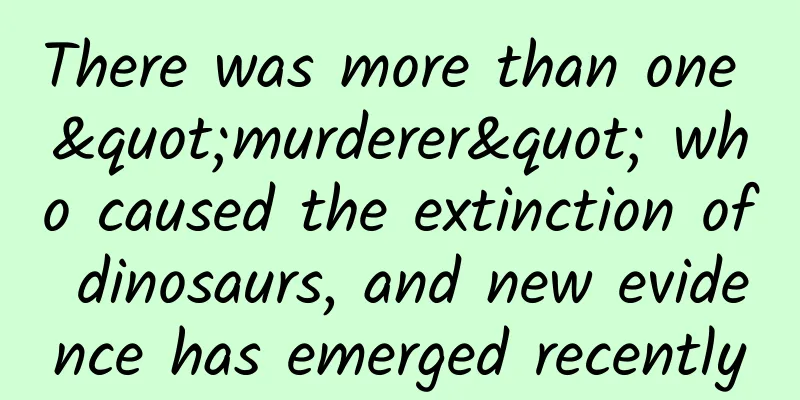There was more than one "murderer" who caused the extinction of dinosaurs, and new evidence has emerged recently

|
In the long history of the Earth's evolution, there have been many ancient creatures that amaze us, such as dinosaurs. Unfortunately, most of these ancient creatures have long disappeared in large and small extinction events on Earth. The dinosaurs became extinct in the mass extinction event at the end of the Cretaceous period about 66 million years ago. Although the public believes that the Cretaceous mass extinction was caused by an asteroid hitting the Earth due to many movies and popular science propaganda, there is still a huge controversy in the scientific community. Scientists are also constantly looking for clues to the "real culprit". The latest discovery is that there was more than one "murderer" that caused the extinction of dinosaurs, and it may have been a "gang crime." The real culprit of extinction: Volcanic eruption or asteroid impact? In 1978, American Professor Dewey McLean first proposed his view on the cause of the mass extinction at the end of the Cretaceous period: it may be caused by a large-scale volcanic eruption on the earth , which would form a large igneous province and be easily observed by geologists. A large igneous province (LIP) is a large accumulation of igneous rocks in the Earth's crust, either intrusive or eruptive. In 1992, researchers first used this term to describe an igneous accumulation larger than 100,000 square kilometers, where basic igneous rocks erupted or deeply intruded over a geological time interval of millions of years or less. The Deccan Large Igneous Province (DLIP) is the product of massive eruptions of major basaltic lavas at the Cretaceous/Paleogene (K/Pg) boundary and constitutes one of the largest known igneous provinces in the world, covering more than 500,000 km2. The traditional view is that the Deccan Large Igneous Province erupted a large amount of greenhouse gases, which led to climate warming at the time and may have caused the extinction of dinosaurs . This view is further supported by high-precision zircon U-Pb dating of the Deccan basalt volcanic ash. But soon, different opinions were raised . American physicist Luis Alvarez (who won the 1968 Nobel Prize in Physics) and his son Walter Alvarez discovered that the K/Pg boundary strata in Gubbio, Italy contained an abnormally high content of iridium. Iridium, a precious metal of the platinum group, is not found in high concentrations in the earth's crust. Instead, it is abundant in "extraterrestrial objects" such as asteroids. So they proposed the asteroid impact theory, which still has an impact today. This dramatic hypothesis quickly attracted public attention, and scientists subsequently discovered more relevant evidence , such as evidence of asteroid impacts such as tektites in fish gills and amber fossils in the strata at the intersection of the K/Pg boundary. Scientists have also identified the impact site, located on the Yucatan Peninsula in present-day Mexico, and named it the Chicxulub Crater. This is an asteroid with a diameter of about 10 to 15 kilometers, which formed this large crater with a diameter of about 180 kilometers and a depth of about 20 kilometers after the impact. Nobel Prize winner Luis Alvarez (left) and his son Walter Alvarez (right) took a photo in front of the K/Pg boundary in Italy in 1981 (Photo source: wikipedia.org) A new clue from China Li Sha, an associate researcher from the Nanjing Institute of Geology and Paleontology, Chinese Academy of Sciences, has been engaged in the research of this "family murder case" for many years. The research team led by her cooperated with Professor Wan Xiaoqiao of China University of Geosciences (Beijing) and others to follow up on a special clue at the time of the crime - mercury. They conducted a comprehensive comparison of the mercury records in the marine (a general term for sedimentary phases formed in the marine environment) and terrestrial (a general term for sedimentary phases formed in the terrestrial environment) strata near the (K/Pg) boundary. Mercury (Hg), commonly known as quicksilver, is the only metal that exists in liquid form at normal temperature and pressure. Volcanic activity is an important natural source of mercury in geological history, and mercury isotopes can provide effective information for tracing mercury sources, so it is often used by scientists to track large volcanic eruptions in geological history . Mercury has 7 stable isotopes (196Hg, 198Hg, 199Hg, 200Hg, 201Hg, 202Hg, 204Hg). Mercury is one of the few metal elements with significant mass fractionation (abbreviated as Hg-MDF, usually expressed as δ202Hg) and non-mass fractionation (abbreviated as Hg-MIF, usually expressed as Δ199Hg). Mercury isotope fractionation is divided into mass fractionation (MDF) and mass-independent fractionation (MIF). Hg-MDF is related to a series of physical, chemical and biological processes, while Hg-MIF is mainly related to the photoreduction process of divalent mercury (HgII). Mercury isotopes from volcanic sources are close to zero. Terrestrial plants absorb mercury from the atmosphere through their stomata, which may result in the retention of photoreduction signals in leaves (negative MIF bias). These processes tend to produce negative MIF values in continental systems (including plants, coal, soil, and sediments). Scientists can trace the source of mercury by analyzing the numerical values of mercury isotopes in Hg-MIF. The researchers integrated data from 26 key profiles and drill holes around the world and found that the mercury values before or at the K/Pg boundary caused by the Deccan basalt eruption had similar trends to the mercury data at the boundaries of other mass extinction events in the Phanerozoic. The Deccan basalts are of particular interest to scientists, given that volcanic activity has been linked to mass extinction events many times in history. These eruptions are often associated with significant environmental changes and large declines in biodiversity, making the role of the Deccan basalts in the end-Cretaceous extinction event particularly important. Global record of mercury tracers in the Deccan Igneous Province (Image source: Nanjing Institute of Paleontology) The researchers compared the mercury isotope values in profiles and drill hole samples from the Jiaolai Basin and Songliao Basin in China, Meghalaya in the Deccan Plateau in India, StevnsKlin in Denmark, and Bottaccione in Italy, and found that Hg-MIF was close to 0, indicating that the mercury was brought directly out of the mantle by volcanoes without undergoing photoreduction (chemical reduction caused by light excitation). In addition, the researchers also compared the mercury isotope values in profiles and drill hole samples from the Pingyi Basin in China, Bidart in France, Padriciano in Italy, and Bajada del Jagüel in Argentina, and found that Hg-MIF was positive, mainly representing divalent mercury deposition, which was related to the photoreduction of mercury; while in the Jhilmili profile in the Deccan Plateau region of India, Hg-MIF was negative, which was speculated to be related to the input of terrestrial materials caused by volcanoes. Since terrestrial materials (such as soil and vegetation) mainly receive mercury through Hg (0) deposition in the atmosphere, mercury isotopes are usually negative. Schematic diagram of the geological environment represented by different mercury anomalies caused by volcanic activity (Image source: Nanjing Institute of Paleontology) End Cretaceous organisms There is more than one culprit for the mass extinction Schoene et al. (2019) used uranium-lead zircon dating and found that four periods of high-volume eruptions occurred during the Deccan basalt eruption - these are called the four episodes of the Deccan basalts. Mercury studies have shown that mercury records in globally distributed profiles/drillings correspond to the first two episodes of Deccan volcanism: the first episode was the Deccan basalt eruption, which occurred between 66.3 million and 66.15 million years ago. It was this eruption that led to the release of large amounts of carbon dioxide and other greenhouse gases, which led to the late Cretaceous warming event , which also caused the partial extinction, dwarfing, and prevalence of disaster species in marine planktonic foraminifera (disaster species are those species that can spread rapidly and dominate after major disturbances or disasters in the ecosystem, such as mass extinction events). However, the second Deccan basalt eruption was even more terrifying, lasting about 66.1 to 66 million years. The massive eruption not only caused huge climate fluctuations, but also caused large-scale ocean acidification . Under the "roller coaster"-like climate change and extremely harsh and unstable environment, the biological world began to collapse in a chain reaction, and various species began to shrink and die. Against this background, the impact of the asteroid was like the last straw that broke the camel's back, bringing a fatal blow to the Cretaceous creatures. Image credit: National Science Foundation, Zina Deretsky The impact of an asteroid has an extreme impact on the Earth's environment. At the moment of impact, the high temperature and shock wave may instantly wipe out a large amount of life near the impact area, and even microorganisms cannot survive. After this violent impact formed a huge crater with a diameter of nearly 180 kilometers on the surface, huge tsunamis and chain earthquakes further expanded the scope of the disaster, causing the death of more organisms. Then, as the impactor fell, it rained fire on the earth. Large areas of plants were ignited, and the earth was truly burning. Large amounts of carbon dioxide and sulfide were also thrown into the atmosphere, forming sulfuric acid aerosols that spread all over the world. At the same time, a large amount of dust and debris produced by the impact obscured the sun - the earth may be in a state of darkness for many years. This long-term blockage of sunlight severely affected primary producers in the ocean and on land, such as phytoplankton and vegetation, which in turn led to the collapse of the entire food chain. With the reduction of primary producers, the biosphere fell into a long period of famine, further exacerbating the loss of biodiversity. AI-generated Chicxulub crater 66 million years ago, shortly after the impact (Image credit: DALL E) In the end, the Cretaceous mass extinction process restored by Chinese scientists based on mercury data was that the violent volcanic activity in the Deccan Plateau in India first triggered a global decline in biodiversity, and then the asteroid impact brought a fatal blow. Although the case has been solved, the mercury records of the third (approximately 65.9 to 65.8 million years ago) and fourth (approximately 65.6 to 65.5 million years ago) Deccan volcanic activity have not yet been discovered, and it remains to be seen whether future scientists will continue to work hard. References [1]Li, S.*, Grasby, SE, Zhao, event. Geology 50, 1140–1144. [2]Li, S. *, Grasby, SE, Xing, Y., Jarzembowski, EA, Wang, Q., Zhang, H. Wan, X., Wang, B., 2024. Mercury contents and isotope ratios in marine and terrestrial archives across the Cretaceous/Paleocene boundary. Earth-Science Reviews 248, 104635. Planning and production Source: Science Academy (ID:kexuedayuan) Author: Wang Guanqun, Liu Yun, and Li Sha Editor: Yinuo Proofread by Xu Lailinlin |
<<: Why is the time on my work computer slower than that on my phone?
Recommend
This Is Us (All Five Seasons) (Updated to Season 5) HD English Subtitles
This Is Us is an American comedy written by Dan Fo...
The explosion of the “hydrogen balloon” is horrifying, but middle school physics and chemistry knowledge tells you that hydrogen is not to blame!
On New Year's Eve, December 31, 2024, a video...
Marine Life Illustrations | The unicorn arm playing the violin is so cool~
Source: Zhejiang Ocean University...
Note 8 pre-sale price is hard to exceed 10,000 yuan. It seems Samsung has really hurt the hearts of Chinese consumers.
As the annual flagship new product, Samsung has h...
Will the development of artificial intelligence make you unemployed?
The impact of technology on employment dynamics i...
What are the key points to pay attention to when choosing server hosting?
The hosting server can be as small as possible Ev...
How to design a community with high conversion rate?
The addiction model is a set of standardized mode...
Don't sleep like this anymore! Your brain is more likely to have problems and your body will age prematurely...
In real life, many people have two criteria for j...
What is the general cost of an enterprise SEO outsourcing service company based on calculation method?
SEO outsourcing companies usually use keyword com...
Are there any risks of infection after returning from various places after the holidays? CDC reminds: These types of people should postpone their return to work!
The Spring Festival holiday is over and many peop...
WeChat can now send large files! HD videos will not be compressed, iOS already supports it
At noon on November 20, the Tencent WeChat team c...
Kuaishou short video traffic revenue project
Kuaishou short video traffic revenue project Kuai...
[Live] 58 Shen Jian: Structural design of database horizontal segmentation under high concurrency of billions of data volumes
[51CTO.com original article] For many Internet bu...
What is the reason for the sudden change from drought to flood in Henan? Why are there so many floods this year?
Produced by: Science Popularization China Author:...
Lenovo Z5: A truly conscientious and high-quality smartphone that stands out among the thousand-yuan smartphones
Lenovo first launched the "conscientious qua...









